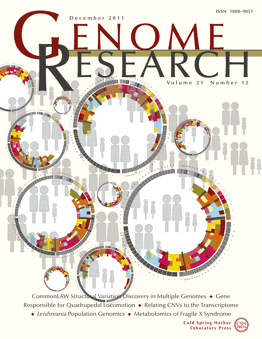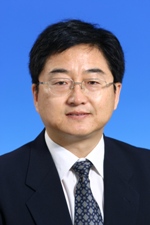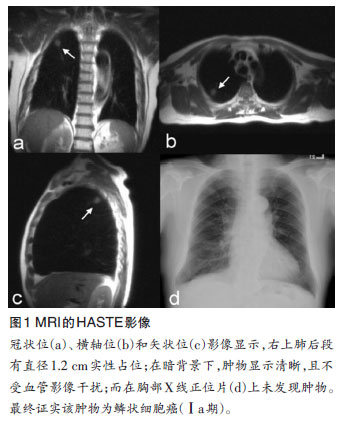Genome Res:非吸烟肺癌者体内有未知的基因融合事件
2012-01-06 MedSci原创 MedSci原创
日前,韩国的研究人员在新一期Genome Research期刊上发表论文"Fusion of KIF5B and RET transforming gene in lung adenocarcinoma revealed from whole-genome and transcriptome sequencing",称发现了未知的基因融合用于解释非吸烟者占到肺癌患者的很大比重,这一发现提供了新疗法

日前,韩国的研究人员在新一期Genome Research期刊上发表论文"Fusion of KIF5B and RET transforming gene in lung adenocarcinoma revealed from whole-genome and transcriptome sequencing",称发现了未知的基因融合用于解释非吸烟者占到肺癌患者的很大比重,这一发现提供了新疗法的靶点。
利用基因组测序和RNA测序,研究小组特征化地描述了之前未知的基因融合事件,研究的案例是, 33岁大的韩国男性患有肺癌却没有吸烟史和家族遗传史。参与研究的科学家分别来自Macrogen公司、医用基因组研究所-首尔国立大学、首尔圣母医院、首尔国立大学医学院和Psoma Therapeutics公司。
Jeong-Sun Seo 博士是医用基因组研究所-首尔国立大学的负责人、Macrogen公司的主席以及该研究的资深作者,他说:“基因组测序技术能够解释之前隐藏的人类癌症的病因,个性化的癌症治疗可依此作为医用靶点。”
测序后,研究小组比较了病人血液中癌细胞和正常细胞的基因组,在已知的癌症相关基因(如,EGFR、KRAS和EML4-ALK)中没有发现突变,通常这些基因的突变可解释这一病例。进一步研究发现,癌细胞中提取的RNA测序后能揭示基因重排事件,这一现象很可能是肿瘤发生的诱导因子,而在基因组测序时很难被发现。
从RNA序列分析中,研究人员建立了一系列的候补基因融合事件,并把诱癌因子归结为单一事件,即KIF5B 和RET融合,10号染色体上出现该基因的反转。这一融合事件之所以令人感兴趣,是因为之前的研究提到了RET基因与其它基因的融合是甲状腺癌症的诱因,尽管它在肺中表达水平低,但是在病人身上高表达。此外,KIF5B的蛋白结构域在启动基因融合事件中不可或缺。
作者提到KIF5B-RET融合出现在大约6%的肺癌患者身上,这一概率值需要进一步验证,研究人员希望该融合基因能成为医疗的分子靶点。(生物谷Bioon.com)
Fusion of KIF5B and RET transforming gene in lung adenocarcinoma revealed from whole-genome and transcriptome sequencing
Young Seok Ju,Won-Chul Lee,Jong-Yeon Shin,Seungbok Lee,Jeong-Sun Seo
Identification of the molecular events which drive cancer transformation is essential to the development of targeted agents which improve the clinical outcome of lung cancer. Many studies have reported genomic driver mutations in non-small cell lung cancers (NSCLC) over the past decade, however, the molecular pathogenesis of more than 40% of NSCLC is still unknown. To identify new molecular targets in NSCLC, we performed the combined analysis of massively parallel whole-genome and transcriptome sequencing for cancer and paired normal tissue of a 33-year-old lung adenocarcinoma patient, who is a never-smoker and has no familial cancer history. The cancer showed no known driver mutation in EGFR or KRAS and no EML4-ALK fusion. Here we report a novel fusion gene between KIF5B and RET proto-oncogene caused by a pericentric inversion of 10p11.22-q11.21. This fusion gene overexpresses chimeric RET receptor tyrosine kinase, which could spontaneously induce cellular transformation. We identified the KIF5B-RET fusion in two more cases out of twenty primary lung adenocarcinomas in the replication study. Our data demonstrate that a subset of NSCLC could be caused by a fusion of KIF5B and RET, and suggest the chimeric oncogene as a promising molecular target for the personalized diagnosis and treatment of lung cancer.
版权声明:
本网站所有注明“来源:梅斯医学”或“来源:MedSci原创”的文字、图片和音视频资料,版权均属于梅斯医学所有。非经授权,任何媒体、网站或个人不得转载,授权转载时须注明“来源:梅斯医学”。其它来源的文章系转载文章,本网所有转载文章系出于传递更多信息之目的,转载内容不代表本站立场。不希望被转载的媒体或个人可与我们联系,我们将立即进行删除处理。
在此留言








#基因融合#
55
#非吸烟肺癌#
61
#融合#
65